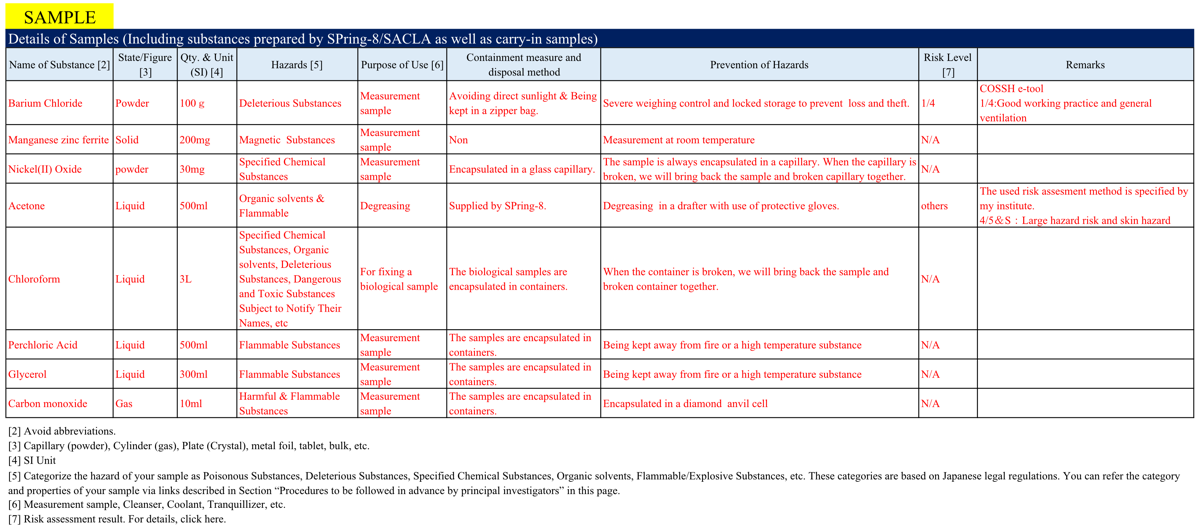Risk Assessment of Chemicals
Any organization of project leaders handling chemicals is obliged to perform a risk assessment of the chemicals and describe the results in the application form, as stipulated in a new Japanese regulation effective from 1 June 2016, as follows.
Outline
- Investigate the severity and possibility of health problems caused by the chemicals, and then evaluate the hazard risk level in handling them. Consider measures to control the exposure of workers to the chemicals to reduce the hazard risk.
- Make an effort to apply the measures to reduce the hazard risk efficiently.
- The chemicals used in the proposed experiments at SPring-8/SACLA must also be assessed by the persons/organizations in charge of the experiments. JASRI requires project leaders to report the results of the risk assessment and refers to the reports in the safety reviews of submitted proposals.
Chemicals to be assessed
- Legal chemicals should be assessed for their hazard risk.
- If you use chemicals other than the listed chemicals, your risk assessment of the chemicals will be greatly appreciated.
- Please assess every legal chemical you will use in your proposals as well as carry-in samples, including the chemicals prepared by SPring-8/SACLA.
- If a chemical sample is encapsulated in a container (for example, a capillary, a capped glass bottle, or a zipper bag) and it is not opened during your stay at SPring-8/SACLA, a risk assessment for its hazard risk is not necessary because no one will have been exposed to the chemical at SPring-8/SACLA.
Risk assessment procedures
- Perform a risk assessment for each proposal.
- Report the result of the risk assessment performed at the project leader’s organization in your proposal form online (in the application form “Known Safety Hazards and Measures to Be Taken”).
- If your organization has not performed a risk assessment of chemicals, we recommend you perform ECETOC TRA, a simple practical method to evaluate hazard risks and to control exposure to chemicals.
- If you have any questions on performing risk assessment, please contact the JASRI Safety Office.
Reporting risk assessment results
Report the assessment results by selecting one number from the pull-down menu in the Risk Level field (4- or 5-level rating system). Larger numbers mean higher hazard risks.
In the recommended system for supporting risk assessment provided by the Ministry of Health, Labour and Welfare, each number has the following meaning.
- 5: Unallowable risk
- 4: Major risk
- 3: Moderate risk
- 2: Allowable risk
- 1: Minor risk
If there are no suitable choices in the pull-down menu, please select “Other” and enter the assessment result in the “Remarks” field (e.g., “3/7” for the risk level being 3 out of 7 stages). Also in this case, larger numbers should mean higher hazard risks. Select “N/A” for chemicals that are exempt from the regulation.

If you have performed risk assessment by a method other than the control banding recommended by the Ministry of Health, Labour and Welfare, please enter the name of the risk assessment system and the results (e.g., hazard risks, proposed measures to reduce the exposure) in the “Remarks” field.
If some measures are required to reduce the risk to your health according to the result of the risk assessment, please enter your safety measures in the “Prevention of Hazards” field.
If you use a very small quantity of the assessed chemical or use it for a very short period and hence you expect the actual risk level to be sufficiently small even in the case of a high evaluated hazard risk, please make a note of this in the “Remarks” field.
Notes
- If you use the system for supporting risk assessment provided by the Ministry of Health, Labour and Welfare (URL), we strongly recommend that you access the system sufficiently in advance of the submission deadline to avoid last-minute technical problems and possible network congestion caused by heavy online traffic.
- The results of the risk assessment provided in application forms are referred to by JASRI for safety reviews and will not directly affect the review results of submitted proposals.
Reference
Revision of Industrial Safety and Health Act and Risk Assessment
Contact
| Contact | Phone | E-mail address |
| JASRI Safety Office | +81-791-58-0874 | safety@spring8.or.jp |


